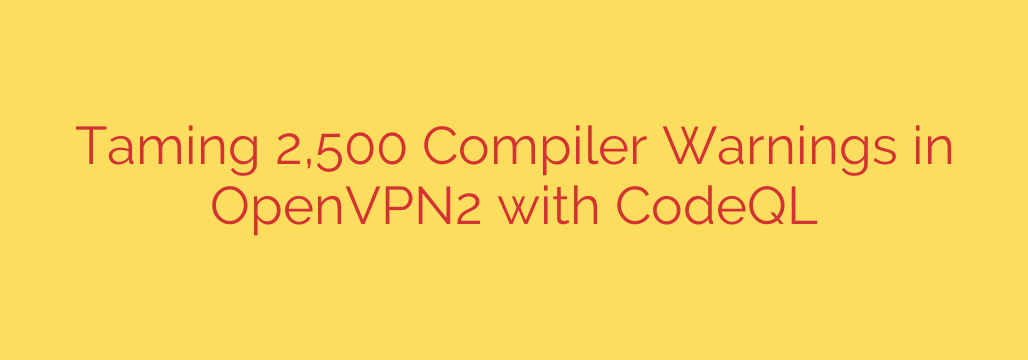
From Chaos to Clarity: How Eliminating 2,500 Compiler Warnings Fortified a Major Open-Source Project
In the world of software development, compiler warnings are like a persistent, low-grade fever. A few might be harmless, but a high number often signals a deeper underlying issue. When developers become accustomed to seeing hundreds or even thousands of warnings during a build, a dangerous phenomenon known as “warning fatigue” sets in. Critical alerts get lost in the noise, and real bugs—some with serious security implications—can slip through the cracks.
This was precisely the challenge faced by the team behind OpenVPN2, a cornerstone of internet security. Their codebase had accumulated over 2,500 compiler warnings, creating a significant amount of technical debt that made the software harder to maintain and secure. Manually fixing each warning one by one was not a viable option. Instead, they adopted a powerful, systematic approach using advanced static analysis that offers a masterclass in modern code hygiene.
The Dangers of Warning Overload
It’s easy to dismiss compiler warnings as non-critical issues, especially when a program still compiles and runs. However, this perspective is shortsighted and risky. A high volume of compiler warnings can:
- Mask Critical Bugs: A brand-new warning indicating a severe logic error or potential vulnerability can easily be overlooked when it’s just one among thousands.
- Hinder Modernization: Adopting newer, stricter compiler flags or evolving the codebase becomes nearly impossible when the initial build is already flooded with alerts.
- Increase Onboarding Time: New developers face a steep learning curve trying to distinguish between “safe” warnings and genuinely problematic code.
- Degrade Code Quality: It fosters a culture where minor issues are ignored, leading to a gradual but steady decline in the overall health of the codebase.
The core problem is that you can’t see the forest for the trees. A clean build with zero warnings is the only effective baseline for identifying new problems as they are introduced.
A Smarter Strategy: Treating Code as Data
Instead of a brute-force manual cleanup, the team turned to CodeQL, a powerful static analysis engine. The genius of this approach is that CodeQL doesn’t just scan text; it treats the entire codebase as a queryable database. This allows developers to write specific queries to find and flag entire classes of problems across millions of lines of code with incredible precision.
This transformed the task from a tedious, error-prone manual effort into a scalable, strategic initiative. The key was to categorize the 2,500 warnings into distinct types and then write a targeted query to identify every single instance of each problem. This ensured that related bugs were fixed consistently across the entire project.
Tackling Common Warnings with Precision Queries
By grouping the warnings, the team was able to methodically eliminate entire categories of potential bugs. Some of the most common issues they addressed included:
- Unused Variables and Parameters: While often benign, unused variables can indicate dead code, unfinished refactoring, or flawed logic. A single query identified all instances, allowing for a swift and comprehensive cleanup.
- Implicit Fallthroughs in
switchStatements: In C, forgetting abreakstatement in aswitchcase can cause code to “fall through” and execute the next case unintentionally. This is a classic source of bizarre and hard-to-diagnose bugs. A CodeQL query located every missingbreak, securing the logic in dozens of places. - Format String Mismatches: Mismatches between
printfformat specifiers (like%dor%s) and the actual arguments passed can lead to crashes, corrupted data, or even security vulnerabilities. Static analysis pinpointed every one of these mismatches for correction. - Signed vs. Unsigned Integer Comparisons: Comparing signed and unsigned integers is a notorious source of bugs in C, often leading to unexpected behavior, especially with negative numbers. By querying for these specific comparison types, the team could audit and fix potentially flawed logic.
By repeating this process for each category of warning, the team drove the warning count down from 2,500 to nearly zero.
Key Takeaways for Your Development Team
The success of this initiative provides a clear blueprint for any organization looking to reduce technical debt and improve software quality. The result is a more secure, stable, and maintainable codebase where new warnings immediately stand out as potential threats.
Here are some actionable security and development tips inspired by this approach:
- Adopt a Zero-Warning Policy: Make it a team goal to maintain a clean build. Treat every new compiler warning as a bug that must be fixed before the code is merged. This prevents the gradual accumulation of technical debt.
- Leverage Advanced Static Analysis: Don’t rely solely on your compiler’s built-in warnings. Integrate powerful static analysis tools (like CodeQL, SonarQube, or others) into your CI/CD pipeline to automatically detect entire classes of bugs.
- Fix Problems Systematically: When facing a large number of existing issues, categorize them first. Tackle one category at a time to ensure consistency and efficiency. This is far more effective than fixing issues randomly.
- Invest in Code Hygiene: Cleaning up warnings isn’t just about tidiness. It is a direct investment in the security, stability, and long-term maintainability of your software. A clean, warning-free codebase is easier to debug, faster to enhance, and safer for your users.
Source: https://blog.trailofbits.com/2025/09/25/taming-2500-compiler-warnings-with-codeql-an-openvpn2-case-study/








